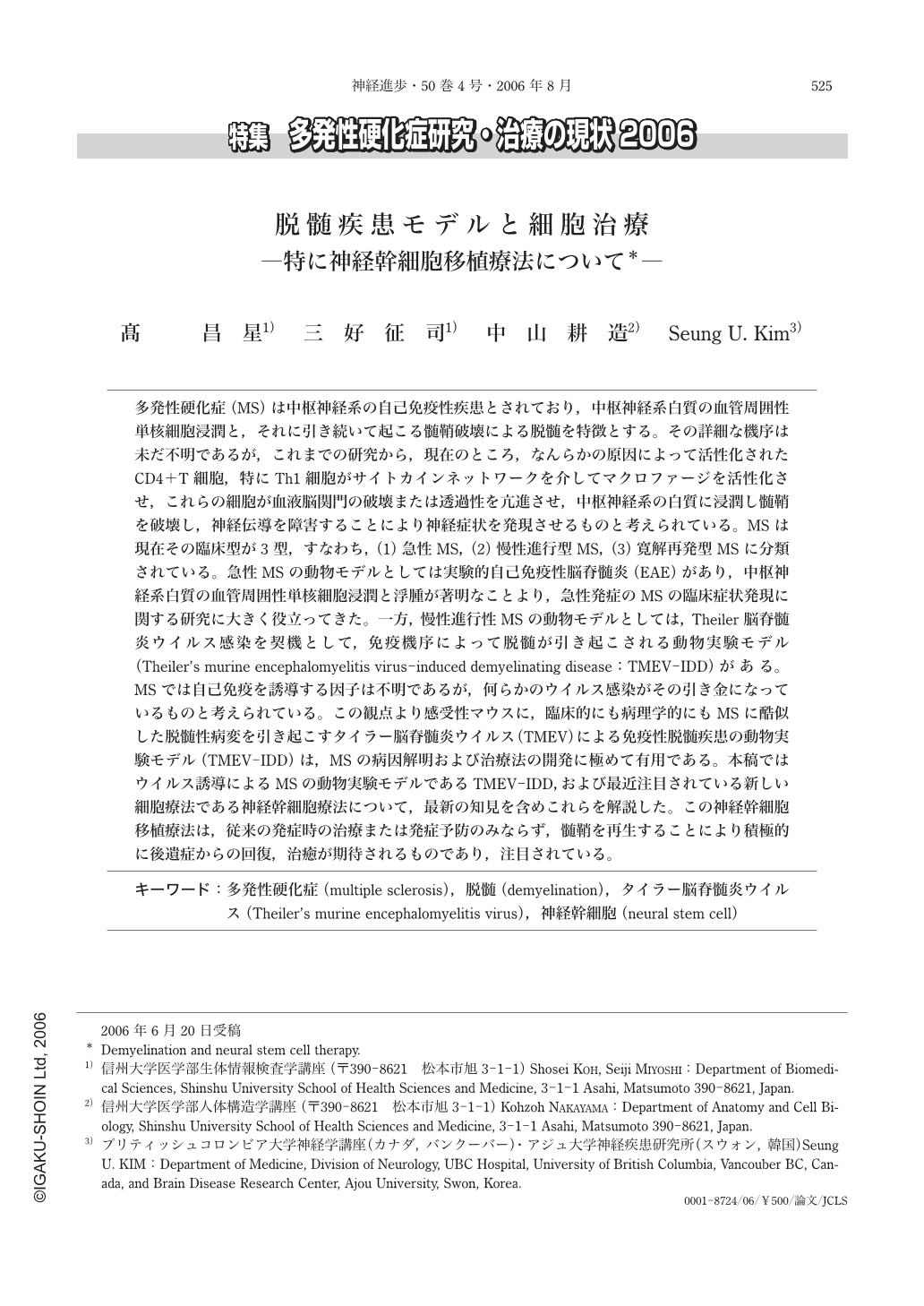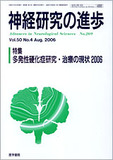Japanese
English
- 有料閲覧
- Abstract 文献概要
- 1ページ目 Look Inside
- 参考文献 Reference
多発性硬化症(MS)は中枢神経系の自己免疫性疾患とされており,中枢神経系白質の血管周囲性単核細胞浸潤と,それに引き続いて起こる髄鞘破壊による脱髄を特徴とする。その詳細な機序は未だ不明であるが,これまでの研究から,現在のところ,なんらかの原因によって活性化されたCD4+T細胞,特にTh1細胞がサイトカインネットワークを介してマクロファージを活性化させ,これらの細胞が血液脳関門の破壊または透過性を亢進させ,中枢神経系の白質に浸潤し髄鞘を破壊し,神経伝導を障害することにより神経症状を発現させるものと考えられている。MSは現在その臨床型が3型,すなわち,(1)急性MS,(2)慢性進行型MS,(3)寛解再発型MSに分類されている。急性MSの動物モデルとしては実験的自己免疫性脳脊髄炎(EAE)があり,中枢神経系白質の血管周囲性単核細胞浸潤と浮腫が著明なことより,急性発症のMSの臨床症状発現に関する研究に大きく役立ってきた。一方,慢性進行性MSの動物モデルとしては,Theiler脳脊髄炎ウイルス感染を契機として,免疫機序によって脱髄が引き起こされる動物実験モデル(Theiler's murine encephalomyelitis virus-induced demyelinating disease:TMEV-IDD)がある。MSでは自己免疫を誘導する因子は不明であるが,何らかのウイルス感染がその引き金になっているものと考えられている。この観点より感受性マウスに,臨床的にも病理学的にもMSに酷似した脱髄性病変を引き起こすタイラー脳脊髄炎ウイルス(TMEV)による免疫性脱髄疾患の動物実験モデル(TMEV-IDD)は,MSの病因解明および治療法の開発に極めて有用である。本稿ではウイルス誘導によるMSの動物実験モデルであるTMEV-IDD,および最近注目されている新しい細胞療法である神経幹細胞療法について,最新の知見を含めこれらを解説した。この神経幹細胞移植療法は,従来の発症時の治療または発症予防のみならず,髄鞘を再生することにより積極的に後遺症からの回復,治癒が期待されるものであり,注目されている。
Multiple sclerosis(MS)is an autoimmune-mediated disease of the central nervous system(CNS), characterized by mononuclear cell perivascular inflammation and localized myelin destruction. Despite scientific and clinical research into MS, the inducing antigen(s)and precise immunologic mechanisms involved in the induction and chronic courses of MS are still poorly understood. It might be an infectious agent, a component of self or pathogen that contains a peptide that mimics self. Intracerebral infection of susceptible strains of mice with Theiler's murine encephalomyelitis virus(TMEV)leads to a chronic immune-mediated demyelinating disease of the CNS that is very similar to human MS. Our recent studies have utilized this well-characterized animal model of MS, TMEV-induced demyelinating disease(TMEV-IDD), serving as ideal system to examine the inducing specificities and the potential therapies during the course of the disease.
Neural stem cells(NSCs)are progenitor cells of the central nervous system(CNS), which could proliferate continuously and produce cells of same kind and multipotential to become neurons or glial cells when proper signals are given. Presence of NSCs has been identified not only in developing human brain but also in adult human brain. Recent studies have demonstrated that NSCs isolated from embryonic or adult mammalian brain can be propagated in vitro and then implanted into the brain of animal models of human neurological disorders including Parkinson disease, Huntington disease, stroke, and importantly MS. Restoring brain function by cell replacement is a new therapeutic approach with great potential for treating human neurological disorders. During the past 15 years, clinical trials in Parkinson disease(PD)patients have shown a great success in cell replacement therapy. Functional deficits caused by death of dopaminergic neurons in human midbrain was reversed by implantation of human mesencephalic neurons isolated from aborted embryo brain. Similar therapeutic approach could be adopted for treatment of MS patients by transplantation of human myelin forming glial cells into brain lesions. This approach has previously been successful in animal models of MS in which remyelination was demonstrated. However this therapeutic approach is not widely accepted because of moral, religious and logistic problems associated with tissue collection of human embryonic/fetal brain cells. This difficulty could be circumvented by utilization of immortalized cell lines of human NSCs. Recently we have produced immortalized cell lines of human NSCs from human embryonic brain using a retroviral vector encoding myc oncogene. These self-renewing human NSCs give rise to neurons, astrocytes and importantly oligodendrocytes(OLGs), myelin forming cells of the CNS. Recently we have generated a subline of human NSC line encoded with Olig2, the bHLH transcription factor gene most important for genesis of oligodendrocytes. This human neural stem cell line, F3. Olig2. C2, expresses cell type-specific markers for oligodendrocytes, galactocerebroside, O1, O4, PLP and CNPase(see attached figure). It has been known that two genes are important for development of oligodendrocytes:Olig2, a bHLH transcription factor, and Nkx2.2, a homeodomain transcription factor. Since F3 human NSC line carries Nkx2.2 endogenously we have transduced the cell line with Olig2 gene. The human NSCs could replace lost OLGs in demyelination plaques of MS patients' brain. As a first step toward this goal, we have applied to graft human NSCs(F3. Olig2. C2)in the brain of SJL/J mice with TMEV-IDD.

Copyright © 2006, Igaku-Shoin Ltd. All rights reserved.


